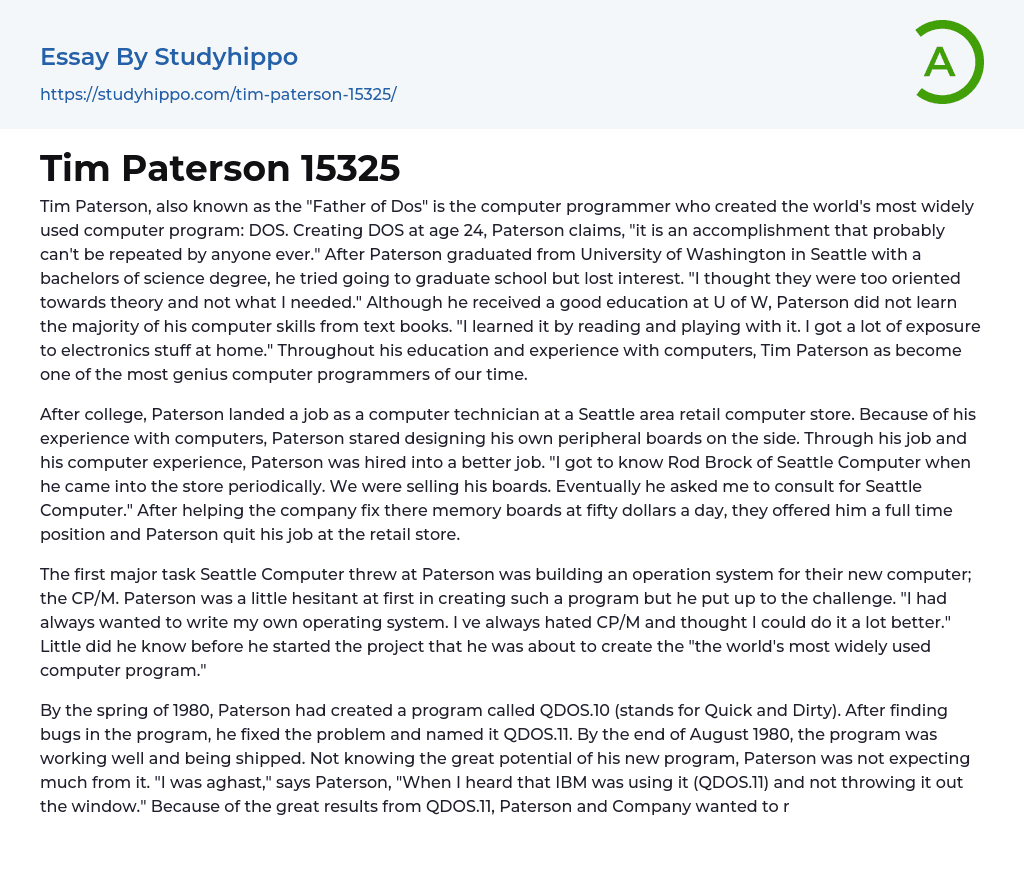Tim Paterson, also known as the "Father of Dos" is the computer programmer who created the world's most widely used computer program: DOS. Creating DOS at age 24, Paterson claims, "it is an accomplishment that probably can't be repeated by anyone ever." After Paterson graduated from University of Washington in Seattle with a bachelors of science degree, he tried going to graduate school but lost interest. "I thought they were too oriented towards theory and not what I needed." Although he received a good education at U of W, Paterson did not learn the majority of his computer skills from text books. "I learned it by reading and playing with it. I got a lot of exposure to electronics stuff at home." Throughout his education and experience with computers, Tim Paterson as become one of the most genius compute
...r programmers of our time.
After college, Paterson landed a job as a computer technician at a Seattle area retail computer store. Because of his experience with computers, Paterson stared designing his own peripheral boards on the side. Through his job and his computer experience, Paterson was hired into a better job. "I got to know Rod Brock of Seattle Computer when he came into the store periodically. We were selling his boards. Eventually he asked me to consult for Seattle Computer." After helping the company fix there memory boards at fifty dollars a day, they offered him a full time position and Paterson quit his job at the retail store.
The first major task Seattle Computer threw at Paterson was building an operation system for their new computer; the CP/M. Paterson was a little hesitant a
first in creating such a program but he put up to the challenge. "I had always wanted to write my own operating system. I ve always hated CP/M and thought I could do it a lot better." Little did he know before he started the project that he was about to create the "the world's most widely used computer program."
By the spring of 1980, Paterson had created a program called QDOS.10 (stands for Quick and Dirty). After finding bugs in the program, he fixed the problem and named it QDOS.11. By the end of August 1980, the program was working well and being shipped. Not knowing the great potential of his new program, Paterson was not expecting much from it. "I was aghast," says Paterson, "When I heard that IBM was using it (QDOS.11) and not throwing it out the window." Because of the great results from QDOS.11, Paterson and Company wanted to refine the system and create 86-DOS, .33. By December 1980, they completed the task. It combined all the information the company knew and condensed it into this one program. At this point, 86-DOS was being sold to OEM's (original equipment manufacturers) and big name companies like Microsoft.
While modifying 86-DOS, Paterson decided that he could do better working for Microsoft instead of staying at Seattle Computer. By joining Bill Gates and going to Microsoft, he would be able to modify his DOS program to a PC-DOS program full-time. Once Paterson switched to Microsoft, they wanted to take everything that went with him, which included DOS. Seattle Computer was willing to sell the program to them. It was a good move from
both companies. Seattle Computer did not have the "marketing clout" that Microsoft had, and Microsoft was benefiting from receiving a quality Computer Program. Now that Paterson was working for a larger corporation, big companies such as IBM wanted better computer programs to fit their computers. So Paterson headed up the division to make an eleven versions of MS-DOS. With these high demands came a lot of bickering from the company. "The whole process drove me crazy. A lot of bugs - PTR's (Program Trouble Reports)--kept dribbling in and IBM would make a telephone call a day. It really drove me nuts. I felt like a puppet on a string." Two months after the project was complete Paterson decided to return to Seattle Computer. Paterson wanted to see himself progress through the company, and that would not happen at Microsoft. He already owned 10% of Seattle Computer and was an officer and member of the board. Eventually, Paterson left Seattle Computer again. He was working ridiculous hours and did not see the point in loosing time with his family, and leisure time. He now only works four days a week at Microsoft and enjoys spending time with his grandson, and going off-road driving with his wife Penny. He is looking forward to retiring and traveling in a motor home around the country. The contributions that Tim Paterson has made to the computer world will be remembered always.
- Computer File essays
- Desktop Computer essays
- Servers essays
- Camera essays
- Cell Phones essays
- Computer essays
- Ipod essays
- Smartphone essays
- Android essays
- Application Software essays
- Benchmark essays
- Computer Network essays
- Computer Programming essays
- Computer Security essays
- Computer Software essays
- Cryptography essays
- Data collection essays
- Data Mining essays
- Graphic Design essays
- Information Systems essays
- Internet essays
- Network Security essays
- Website essays
- World Wide Web essays
- Cloud Computing essays
- Computer Science essays
- Consumer Electronics essays
- Data Analysis essays
- Electronics essays
- engineering essays
- Enterprise Technology essays
- Hardware essays
- Impact of Technology essays
- Information Age essays
- Information Technology essays
- Modern Technology essays
- Operating Systems essays
- people search essays
- Robot essays




